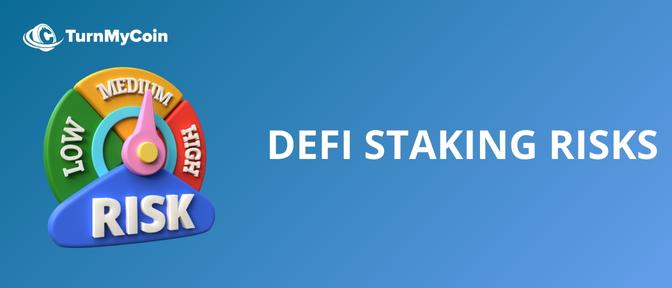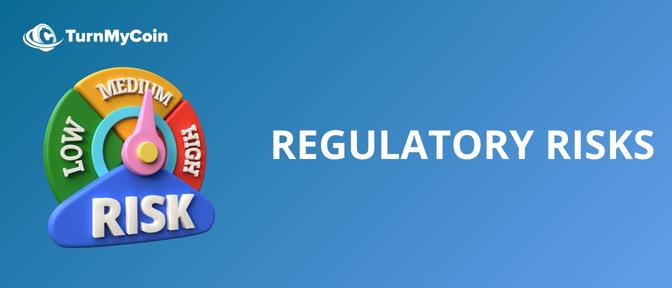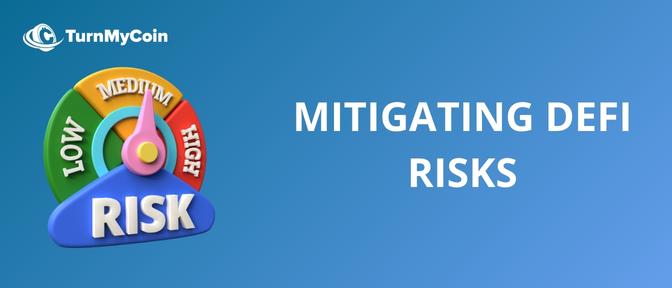Last updated on January 19th, 2024 at 06:46 am

In recent months, the cryptocurrency space has been buzzing about DeFi risk. DeFi projects aim to shift power from governments to the people. For example, DeFi platforms promise to provide instant loans, as opposed to the several days of paperwork required by traditional financial institutions.
With the growth of DeFi, many investors are staking on different projects. However, the major issue is that many participants don’t understand the risks associated with these projects. Recent months have seen scandals involving various DeFi projects, leading to increased fear among investors.
Table of Contents
DeFi Staking Risks

Decentralized Finance (DeFi) staking is a process that involves locking funds in a smart contract, in exchange for rewards or a percentage of transaction fees. Although the practice of staking has become popular among cryptocurrency enthusiasts, it comes with considerable risks that must be carefully considered. One of the most significant risks associated with DeFi staking is the presence of vulnerabilities within smart contracts.
Smart contracts are self-executing agreements that are defined by lines of code between buyers and sellers. However, any errors in the code can result in significant losses. DeFi projects are not immune to these vulnerabilities, and as a result, several projects have been hacked, leading to massive losses for stakers.
Another considerable risk associated with DeFi staking is the potential loss of funds due to market volatility or low liquidity. Liquidity is , When an asset can be bought or sold without affecting its price.
When liquidity is low, stakers may be unable to sell their tokens on the market, resulting in a considerable loss of funds. Additionally, stakers may suffer losses due to sudden drops in the value of their staked tokens caused by market volatility.
Numerous instances of DeFi staking risks and losses have been reported in recent months. In 2020, the YAM project, which had attracted significant attention due to its unique staking mechanism, experienced a catastrophic loss due to a bug in its smart contract. Similarly, the Cover Protocol, which provided decentralized coverage for DeFi projects, was hacked, leading to the loss of more than $3 million worth of staked funds.
While DeFi staking may offer significant rewards, it also comes with significant risks that must be carefully considered before investing. To mitigate these risks, investors must perform thorough research, understand the potential vulnerabilities , and keep track of market trends and liquidity.
Yield Farming Risks

Yield farming has become one of the most popular ways for DeFi participants to earn returns on their investments. It involves lending or staking crypto assets in a liquidity pool to earn rewards in the form of new tokens or fees. However, yield farming possess certain level of risk.
One of the main risks associated with yield farming is impermanent loss, which occurs when the price of the assets in the liquidity pool changes. This can lead to a loss of value for the assets in the pool, which can result in a decrease in returns for the yield farmer. Additionally, smart contract vulnerabilities can also pose a risk for yield farmers. If a smart contract is compromised, it can result in the loss of funds for the yield farmer.
To mitigate the risks associated with yield farming, it is important to conduct thorough research and due diligence before investing in a particular liquidity pool. This includes understanding the underlying assets in the pool, as well as the smart contracts and protocols that govern the pool.
There have been several high-profile examples of yield farming risks and losses in the DeFi space. For example, in August 2020, the Yam Finance project suffered a critical flaw in its smart contract that resulted in the loss of millions of dollars worth of investor funds. Similarly, in February 2021, the Meerkat Finance project suffered a hack that resulted in the loss of $31 million in investor funds.
Liquidity Pool Risks

Liquidity pools are a pivotal constituent of the DeFi environment, serving as a vital source of liquidity for trading and other DeFi undertakings. These pools of tokens are locked within ingenious contracts and are deployed to expedite trades on decentralized exchanges. In reciprocation for providing liquidity to the pool, users obtain trading fees and rewards in the form of supplementary tokens. Nonetheless, participating in these liquidity pools does entail some peril.
One of the principal hazards associated with liquidity pools is the defi risk of smart contract vulnerabilities. These smart contracts are software programs that govern the actions of the liquidity pool, and if any glitches or flaws exist within the code, it may culminate in the forfeiture or filching of funds. Another potential risk is the peril of market instability leading to liquidations. If the tokens’ value within the liquidity pool drastically fluctuates, it may instigate liquidations that lead to losses for liquidity providers.
The bZx incident that transpired in 2020 exemplifies the risks and losses that may result from participating in liquidity pools. In this particular case, the exploitation of a smart contract vulnerability resulted in liquidity providers losing more than $1 million. Another instance of liquidity pool risks and losses is the 2021 Iron Finance incident. The sudden plunge in the TITAN token’s value triggered a liquidity crisis, which led to significant losses for liquidity providers.
Regulatory Risks

Regulatory risks in DeFi can take many forms. One major risk is that regulators could crack down on DeFi projects. This could lead to legal challenges and potential enforcement action by regulatory bodies. Another regulatory risk is the possibility of future regulations being introduced that could impact the DeFi space.
This could lead to changes in the way DeFi projects operate, potentially causing disruptions and legal challenges for those involved. There are already examples of regulatory issues in DeFi. In late 2020, the U.S. Securities and Exchange Commission (SEC) brought a lawsuit against Ripple Labs, the creators of the XRP cryptocurrency. Claiming that XRP was a security that had been sold without proper registration. This legal action caused many cryptocurrency exchanges to delist XRP, leading to a significant drop in its value.
The case is still ongoing, but it highlights the potential legal and regulatory challenges that can arise in the DeFi space. Another example of defi risk is the possibility of being caught up in money laundering or other illegal activities. Since DeFi platforms often operate with a high degree of anonymity. It can be challenging to detect or prevent these activities. Regulators may step in to impose stricter anti-money laundering and know-your-customer requirements. Potentially creating challenges for DeFi projects and their users.
Mitigating DeFi Risk

DeFi, despite its potential, carries inherent risks. There are, however, a variety of measures that can be taken to alleviate such concerns. Foremost among them is diligent research and inquiry prior to investing. This entails understanding the technology supporting DeFi as well as the hazards associated with it. Furthermore, investors should scrutinize the code of the smart contracts they engage with in order to detect any possible vulnerabilities.
Diversification is also a pivotal method for mitigating DeFi risks. It is unwise to entrust all of one’s funds to a single project. They should be dispersed across numerous projects to minimize the impact of any individual project’s collapse. Additionally, it is advisable to invest in established DeFi projects. Which have a strong record of performance and have been audited by reputable third-party firms.
Another strategy is to stay current on regulatory developments in the DeFi sector. Although DeFi currently functions in a largely unregulated environment, this may change in the future. Investors should remain up to date on any regulatory changes that could affect the projects in which they are invested.
Lastly, it is critical to bear in mind that DeFi is still a nascent and evolving technology. While risks are indeed present, so too are opportunities for substantial returns. Investors who invest the time necessary to understand the risks and implement appropriate risk management strategies can participate in DeFi’s growth while limiting their exposure to potential losses.
Examples of successful DeFi risk management strategies include investing in established projects. Likewise Aave or Compound, which have a proven track record and are widely used in the DeFi arena. Another option is to utilize decentralized exchanges (DEXs), which allow for more secure and private transactions. Uniswap and Sushiswap are two examples of DEXs that have gained popularity among DeFi investors.
Conclusion
Decentralized Finance (DeFi) is an avenue that avails avant-garde techniques for those willing to embrace the associated difficulties and risks of yield farming. Nonetheless, it is not a facile endeavor, and to thrive in it. You must engage in methodical, meticulous, and sagacious decision-making. When one is confronted with the arduous task of selecting a liquidity pool or platform, knowledge of DeFi risk is indispensable. It empowers